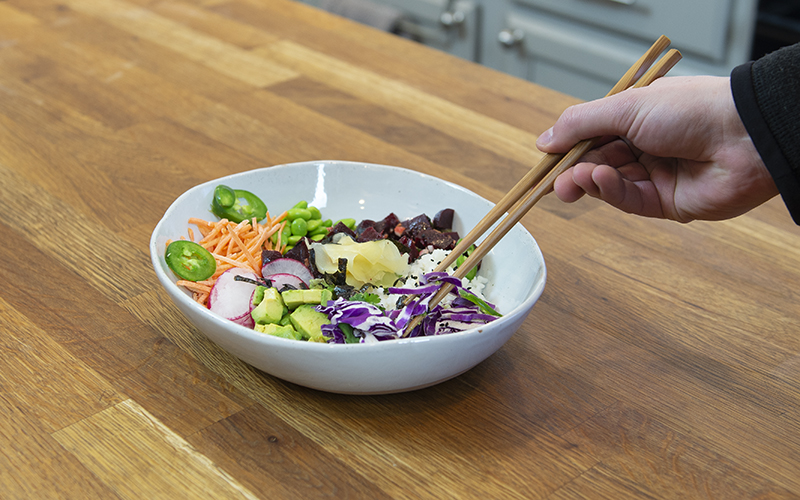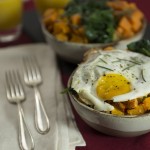
All of a sudden, the humble beet has become chic. Beet juice, beet smoothies, beet chips, beet chews, crispy beet salad toppings — there’s no shortage of new beet products on the shelves these days. It’s no wonder, because beets can’t be beat when it comes to their nutritional benefits, sports-enhancing qualities, and innovative culinary applications. (No more puns, promise!)
Nutritional benefits
The powerful red dye component is probably the most notable feature of beets, and although the staining ability is remarkable, that’s not the most impressive function of the red color. That red is a clue to beets’ outstanding nutritional benefits. They’re packed with fiber, vitamins, and minerals — including vitamin C, potassium, naturally occurring dietary nitrates, and antioxidants. The red pigment of beets is from betalains, phytonutrients linked to antioxidant and anti-inflammatory benefits. Studies of beets have shown positive relationships with reducing blood pressure, improving gut and brain health, providing cancer-fighting properties (through those unique betalains), and showing promising benefits for athletic performance.
Sports-enhancing qualities
Here’s the science behind beets’ athletic-enhancing abilities: the naturally occurring dietary nitrates in beets are reduced to nitric oxide. This gas relaxes and widens blood vessels, which improves blood flow. Improved blood flow allows athletes to work harder without as much impact on their oxygen levels. The Journal of Applied Physiology published a study of exercise performance using beetroot juice, showing about a 15% improvement in the time it took athletes to reach exhaustion. For many athletes, this means higher performance for a longer duration. These levels peak about two to three hours after eating beets, so the best time to eat them is about three hours before a workout, practice, or game.
Innovative culinary applications
For best selection, choose beets that are firm with vibrant greens; smaller beets will be more tender. There are many varieties of beets to choose from, but you’ll likely be able to find garden beets, golden beets, and Chioggia (also called candy cane or candy-striped) beets at your local grocery store or farmers market. Garden beets are slightly sweet and your white shirt’s worst nightmare because of those betalains. They’re used as a natural food coloring and can even dye hair. Golden beets are, as you could guess, more of a golden color and lack that potent red inside. They tend to be a little sweeter than garden beets and have a less distinctive earthy flavor. Chioggia beets are a favorite because of their interesting striped appearance. They’re the sweetest, and their color doesn’t bleed as much as other varieties’ do. The color can fade if you cook them, so they’re most visually appealing when they’re raw.
Enjoy them raw, pickled, cooked, or canned, and use them to add flavor, nutrients, and color to salads, dips, smoothies, and main dishes. If you’re cooking them, save yourself some time (and stains) by preparing the beet with the skin on — just scrub them well first. Have you ever had beet hummus? The color itself is exciting for children to try. Don’t forget the greens — you can eat them raw or cooked like any other green.
If you’re interested in the benefits of beets and looking for a new way to fit them into your diet, try our recipe below.
Servings: 6
Prep Time: 30 minutes
Cook Time: 2 hours
Ingredients:
1 ½ pounds roasted beets
6 ounces steamed white rice
5 green onions
1 ½ nori seaweed sushi sheets
5 peeled, minced fresh garlic cloves
1 tablespoon kosher salt
1 ½ teaspoons ground black pepper
½ cup soy sauce
1 ½ cups toasted sesame oil
4 ½ teaspoons cold water
2 cups edamame
6 ounces shredded carrots
¾ cup sliced radish
3 avocados
1 ½ cups shredded red cabbage
4 ½ teaspoons unsalted toasted sesame seeds
1 each sliced jalapeño
1 handful of cilantro leaves
2 teaspoons pickled ginger
Preparation:
Step 1: Prepare the roasted beets according to the recipe below. Allow them to cool slightly.
Step 2: Prepare the steamed white rice according to the recipe below. Set it aside.
Step 3: Trim and slice the green onions, and cut the nori sheets into strips.
Step 4: Combine the minced garlic, salt, black pepper, green onions, soy sauce, sesame oil, and water to make a dressing; refrigerate it for approximately 15 minutes.
Step 5: Combine the beets with the soy dressing.
Step 6: Place equal amounts of the rice in serving bowls and top with equal amounts of beets, edamame, carrots, radish, avocado, and red cabbage.
Step 7: Garnish with toasted sesame seeds, jalapeños, cilantro, pickled ginger, and nori.
For roasted beets
Ingredients:
2 ¼ pounds beets
2 teaspoons vegetable oil
⅛ teaspoon salt
⅛ teaspoon ground black pepper
Preparation:
Step 1: In a large pot, boil the beets until they’re tender.
Step 2: Preheat your oven to 350°F.
Step 3: Drain the beets, run cold water over them, slip off the skins, and remove the root ends.
Step 4: Cut the beets so all pieces are similar in size.
Step 5: In a roasting pan, toss the beets with the remaining ingredients.
Step 6: Roast for 30-60 minutes or until the edges brown.
For steamed white rice
Ingredients:
1 ½ cups water
1 teaspoon kosher salt
1 cup rice
Preparation:
Step 1: In a small pot, bring the water and salt to a boil.
Step 2: Add the rice and stir. Reduce the heat to the lowest setting, cover the pot, and cook the rice until all water is absorbed, about 15-18 minutes. Do not lift the cover before the end of cooking.
Step 3: Let the rice stand, covered, for 5-10 minutes.




